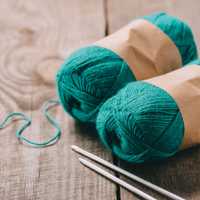Sue's CrochetAndKnitting.com
Craft Tips
Craft Tips
If you have a Craft Tip that you would like to add, Click Here to send an email. I'd like to give you credit for your tips, please state what you would like included, for example, first name, last name, state, province, country. Your email address will not be posted.
Cleaning and Restoring: Vicky writes, "I have an old (55 years or more) hand crocheted cotton ecru bedspread and tablecloth. I would like to have them restored to their original beauty. Any suggestions as to the best method to achieve this?"
Angela suggests.... try OxiClean. I used it on a table cloth and a bedspead and it worked great! Kinda like bleach but doesn't change the antiquey look or hurt the fabric a bit. You can buy it at http://www.asseenontv.com. The stuff works great, I use it on just about everything.
Someone else suggests....
you might try "Oxy-Clean" I can get it at Wal-mart. Really whitens dingy linens.
Cindy in Norris, Tennessee, suggests.... I have had great success in cleaning very stained and soiled quilts with Arm and Hammer washing soda. This is not Borax! Most of the large grocery stores have it. I fill the washing machine with warm water and add about half of a cup and detergent. Then agitate to mix. Then add soiled item and agitate again, let sit overnight and wash and rinse.
Pamela adds.... Oxiclean is also available at wal-mart, walgreens and sams clubs. It would work wonderfully. I have used it often with amazingly good results.
Angela suggests.... try OxiClean. I used it on a table cloth and a bedspead and it worked great! Kinda like bleach but doesn't change the antiquey look or hurt the fabric a bit. You can buy it at http://www.asseenontv.com. The stuff works great, I use it on just about everything.
Someone else suggests....
you might try "Oxy-Clean" I can get it at Wal-mart. Really whitens dingy linens.
Cindy in Norris, Tennessee, suggests.... I have had great success in cleaning very stained and soiled quilts with Arm and Hammer washing soda. This is not Borax! Most of the large grocery stores have it. I fill the washing machine with warm water and add about half of a cup and detergent. Then agitate to mix. Then add soiled item and agitate again, let sit overnight and wash and rinse.
Pamela adds.... Oxiclean is also available at wal-mart, walgreens and sams clubs. It would work wonderfully. I have used it often with amazingly good results.
Help with the Starting Chain in Crochet. If you have to start with a long chain, as for an afghan, and you lose your count, here's a good tip. Keep adding chs until you are sure that it is more than enough. Then turn and do your first row. Simply pick out the left over stitches by pulling the yarn tail back through the loops.
Color Change Tip - Crochet
To make smooth color changes - on the last stitch before you change colors, drop the color you are using before you pull the yarn through the last 2 loops on your hook, pick up the new color and with yarn over your hook, pull through the last 2 loops on your hook.
Here's a tip from Steve concerning my Crocheted Moccasin Style Slippers Pattern. Thank you, Steve!
Thank you for such an enjoyable pattern! I showed one of my first tries at this pattern to my fiancée, and she loved them. However, my first try was for her, and they look right but were too big. After toying with reducing the stitches, I wound up making a simple gauge change to a size E hook. What came out was a tight little boat shape of a slipper (I tweaked it a little), but they fit her size 6 feet, and she loves them! All I need to do is put some tatted (shuttle-tatted) lace on them and her initials, and she'll be very happy. I wouldn't go any smaller with the hook, but you can go down on the ply if you don't want to change the basic shape.
Converting English Crochet Terms to French.
Sabine had written for help.
She is French and knows how to crochet
and understands English, but
as she says, "the terms for american stitchs and french stitch, are different".
Therefore she can't follow the pattern instructions.
She was looking for a
site where the English and French equivalent terms would be listed.
Thanks to Barb in FLA for the following:
The International Dictionary of Crochet Terms.
Knitting Techniques. These sites have some great Knitting tips: http://www.math.unl.edu/~gmeister/papers/Knitting/techniques.html http://knitting.about.com/cs/specialtechniques/ http://knitting.about.com/library/blmosaichowto.htm http://www.geocities.com/plantldy.geo/knitting.html http://www.dawnbrocco.com/tech.html
Long Knitting Needles Kathy writes: My mother is an avid knitter, amongst many other homemade talents - when I started to knit many years ago - I turned to her for advice and when I told her that the knitting needles were too long, she said - cut them off - so my husband immediately took charge and took off the tips where the size of the needle is printed, sawed off the needle to the length I wanted and put the tip back on; from then on - no more long, awkward knitting needles!! One of those 'taken for granted' types of information our elders possess in overabundance.
Alternate Foundation Row Technique - other than the usual long first starting chain (Crochet). Thanks to Carole for bringing this method to my attention. Tips ‘n Trix: Try the Foundation Stitch
Learning to knit with short knitting needles. Elizabeth in NH writes: I was reading your tip Long Knitting needles...my mom taught my daughter how to knit when she was little by taking small needles with points at both ends and all she did was take a small cork and put on other end... my daughter still uses needles today.
Thanks to Ellen for these craft tip links: http://www.knitting-crochet.com/tip.html
This site tells you what you can do with granny squares such as putting
together to make.
http://www.geocities.com/Heartland/Ranch/4054/grannies.htm
Here is a site with tips from other crocheters that may be helpful with
their projects and they want to leave a little help for someone else
http://www.crochetnmore.com/123tips2000.htm
Tips for Beginners.
Thanks to a web site visitor (who wishes to remain anonymous) for these great tips. i can offer tips for some begginning things i have done to help me along ....................if you are having problems keeping up with row or round count i suggest that you find a scrap pc. of paper and something to write with and each row or round that you finish make a mark or write the number down so that when you have to stop for awhile you will know where you left off at (this is really helpful with single crochet as it is hard to keep a count of)....................another suggestion is that there are different ways of holding your hook and yarn and different folks are going to tell you how to hold each but i suggest that you hold each one the way that is most comfortable for you.......................another suggestion is make sure you have a yarn needle threader handy, they are really inexpensive and really help out when you have to use them in your crochet patterns for hiding the leftout yarn ends...............i hope this will help some. thanks
Thanks to Tee for these great tips Re-using cheap store bought slippers to make valuable crochet or knitted slippers with soles that wear much longer. Heres the idea..... We have all seen tons of those cheap cheap cheap slippers/slipper socks/scuffs etc sold at Walmart, Target, KMart and various supermarkets and drug stores (I actually find the supermarket and drug stores to be the cheapest and the best variety believe it or not!).
No one wants to spend the time and effort (and if you're using a nice wool yarn, the money) in making a pair of slippers that will quickly be "walked through" on the bottoms. They simply dont wear so good on the bottoms. Also, the slightest snag and your in for problems!
So what I do is buy a few pairs of the cheapy scuffs (thats what I call those cheap slippers) and use the brand new bottoms for my handmade slippers! The ones that kind of curve up and over the sides are the BEST even if its a dollar more... your custom slippers are WORTH it!
The added benefit is that they will also be waterproof and you can step outside in them! Its not hard to remove them really, you could even use used ones if they are just for your own slippers and you are not making them for someone else. I find that the soles dont wear out much in my store bought scuffs since I am just ambling about on carpet for the most part anyway, and the inside soles wear out faster than the outsole (the rubber part that we want!) do in that case! Some of them even have that 1/2 inch or inch of foam in them!
You can use a razor (if you are careful) or exacto knife to help dissect your scuffs to use the sole. If your lucky your soles will be already attached to the new scuff by a simple stitch running along the edge in a sort of "channel" made in the rubber. You technically wouldnt even need to make a bottom of your slipper in this case (some people dont like the feeling of walking on crochet/knitted slippers unless the stiches are small and close together, unless they wear socks with them, as I always do.).
Another thing you can do is stitch in some nice fleece for the lining on the inside. You can do the entire inside, or just the bottom. I also highly recommend using some kind of adhesive (washproof) to keep things from sliding around down there as you walk. Its not absolutely needed, but the quality of the slipper will increase tenfold with just that extra effort. You only really need it on the soles anyway. This keeps the wearer from "walking over" the edge of the sole and wearing out the edge of the slipper if the person has wide feet especially.
To stitch them on, I recommend using the strongest thread you have, or better yet, use a very strong monofilament fishing line. Then if you would like, you can use a complimentary colored thread (or yarn) over that. I find that embroidery floss can even work in this case. If there are no holes, you can use a poker of some sort (a safety pin or paper clip) heated up under a candle flame (watch that it doesnt burn your fingers!) to make your holes. The space between them will dictate how long your straight stitching will be.
Now, in a whole different ball park.... Your other option is to acutally use the ENTIRE scuff/slipper and then crochet a "cover" for it and simply stitch it right over the whole shebang! Its actually easier than you think, and you are left with a pair of scuffs that cost you 2.99, but became masterpieces with a few grannysquares! If you use a grannysquare or loosely crocheted (or knitted) pattern, its best to choose a color of scuff that will blend in with whatever color yarn you are using. If thats not possible, then you can always use some spray adhesive (or sew it on) a fat quarter of material that would match your crochet work. The benefit of doing it this way is that you dont have to even crochet for the bottom of the slipper, you get a pair that are going to last MUCH longer, and the wearer will have the benefit of added warmth that the extra layer of yarn will give them on top of the plain scuff!
Just thought i would share this idea with you. I see SO many slipper ideas out, and have made my share, and from my own experience if the person realllllllllllllllllly loves them, they wear them a lot and wear right through them all too quickly!
No one wants to spend the time and effort (and if you're using a nice wool yarn, the money) in making a pair of slippers that will quickly be "walked through" on the bottoms. They simply dont wear so good on the bottoms. Also, the slightest snag and your in for problems!
So what I do is buy a few pairs of the cheapy scuffs (thats what I call those cheap slippers) and use the brand new bottoms for my handmade slippers! The ones that kind of curve up and over the sides are the BEST even if its a dollar more... your custom slippers are WORTH it!
The added benefit is that they will also be waterproof and you can step outside in them! Its not hard to remove them really, you could even use used ones if they are just for your own slippers and you are not making them for someone else. I find that the soles dont wear out much in my store bought scuffs since I am just ambling about on carpet for the most part anyway, and the inside soles wear out faster than the outsole (the rubber part that we want!) do in that case! Some of them even have that 1/2 inch or inch of foam in them!
You can use a razor (if you are careful) or exacto knife to help dissect your scuffs to use the sole. If your lucky your soles will be already attached to the new scuff by a simple stitch running along the edge in a sort of "channel" made in the rubber. You technically wouldnt even need to make a bottom of your slipper in this case (some people dont like the feeling of walking on crochet/knitted slippers unless the stiches are small and close together, unless they wear socks with them, as I always do.).
Another thing you can do is stitch in some nice fleece for the lining on the inside. You can do the entire inside, or just the bottom. I also highly recommend using some kind of adhesive (washproof) to keep things from sliding around down there as you walk. Its not absolutely needed, but the quality of the slipper will increase tenfold with just that extra effort. You only really need it on the soles anyway. This keeps the wearer from "walking over" the edge of the sole and wearing out the edge of the slipper if the person has wide feet especially.
To stitch them on, I recommend using the strongest thread you have, or better yet, use a very strong monofilament fishing line. Then if you would like, you can use a complimentary colored thread (or yarn) over that. I find that embroidery floss can even work in this case. If there are no holes, you can use a poker of some sort (a safety pin or paper clip) heated up under a candle flame (watch that it doesnt burn your fingers!) to make your holes. The space between them will dictate how long your straight stitching will be.
Now, in a whole different ball park.... Your other option is to acutally use the ENTIRE scuff/slipper and then crochet a "cover" for it and simply stitch it right over the whole shebang! Its actually easier than you think, and you are left with a pair of scuffs that cost you 2.99, but became masterpieces with a few grannysquares! If you use a grannysquare or loosely crocheted (or knitted) pattern, its best to choose a color of scuff that will blend in with whatever color yarn you are using. If thats not possible, then you can always use some spray adhesive (or sew it on) a fat quarter of material that would match your crochet work. The benefit of doing it this way is that you dont have to even crochet for the bottom of the slipper, you get a pair that are going to last MUCH longer, and the wearer will have the benefit of added warmth that the extra layer of yarn will give them on top of the plain scuff!
Just thought i would share this idea with you. I see SO many slipper ideas out, and have made my share, and from my own experience if the person realllllllllllllllllly loves them, they wear them a lot and wear right through them all too quickly!
Thanks to Kathy from Florida for this great tip. I’m an avid crocheter and I just wanted to let you know after searching and experimenting on handmade socks, I finally found the solution for all of us who knit and crochet socks.
This is the answer to non-skid, non-slip coating for the bottom of yarned socks. It’s called Super-Grip and it is sold at Ace Hardware. It is a spray, so it’s extremely easy to use. Or you can go directly to their website and purchase the product.
I bought some different small stencil sheets at Wal-mart and sprayed the Super-Grip for designs. So dots, lines and squares are good to use for stencil design. The only downfall is the product is only sold in clear, but I’ve already spoken with the manufacturer and they are considering adding colors in response. But clear is good.
Another downfall is when I talked to tech support they said the product does wear off quickly after four or so washes. So I recommend spraying a few more times and let thoroughly dry. The recommended drying time is 8 hours. So two applications should do the trick.
The other thing that somewhat works is Puffy Paint. It’s not as non-skid but it works ok too.
You have a great website and I enjoy it. I’m a columnist for a local newspaper and I used to write the
craft column. I now get to write about anything I want and I’m going to write about crafts for the holidays.
Would you mind if I told my readers about your site? Let me know ASAP about that. Take care and I hope
this was helpful.
Kathy is a columnist for her local newspaper. She is going to be writing about crafts for the holiday season. You can read some of Kathy's archived columns by clicking here.
This is the answer to non-skid, non-slip coating for the bottom of yarned socks. It’s called Super-Grip and it is sold at Ace Hardware. It is a spray, so it’s extremely easy to use. Or you can go directly to their website and purchase the product.
I bought some different small stencil sheets at Wal-mart and sprayed the Super-Grip for designs. So dots, lines and squares are good to use for stencil design. The only downfall is the product is only sold in clear, but I’ve already spoken with the manufacturer and they are considering adding colors in response. But clear is good.
Another downfall is when I talked to tech support they said the product does wear off quickly after four or so washes. So I recommend spraying a few more times and let thoroughly dry. The recommended drying time is 8 hours. So two applications should do the trick.
The other thing that somewhat works is Puffy Paint. It’s not as non-skid but it works ok too.
You have a great website and I enjoy it. I’m a columnist for a local newspaper and I used to write the
craft column. I now get to write about anything I want and I’m going to write about crafts for the holidays.
Would you mind if I told my readers about your site? Let me know ASAP about that. Take care and I hope
this was helpful.
Kathy is a columnist for her local newspaper. She is going to be writing about crafts for the holiday season. You can read some of Kathy's archived columns by clicking here.



